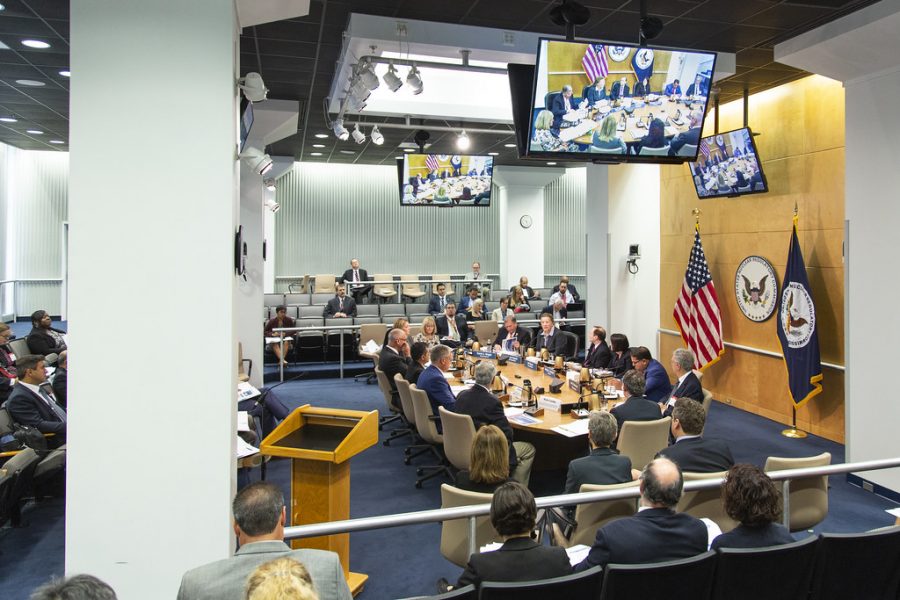Soon after taking office, President Biden nominated Richard Glick, a Democratic commissioner on the Federal Energy Regulatory Commission (FERC), as the Commission’s new chair.[i] Though the Commission is expected to maintain a Republican majority until Commissioner Neil Chatterjee’s term ends June 30, Glick has begun shifting the priorities of FERC, which regulates the interstate transmission and sale of electricity, natural gas, and oil, to align with President Biden’s ambitious energy and environmental goals.[ii] The following examines Glick’s three main priorities under the new administration, each of which could substantially change the energy regulatory landscape.
Tag: Climate-Change Page 2 of 3
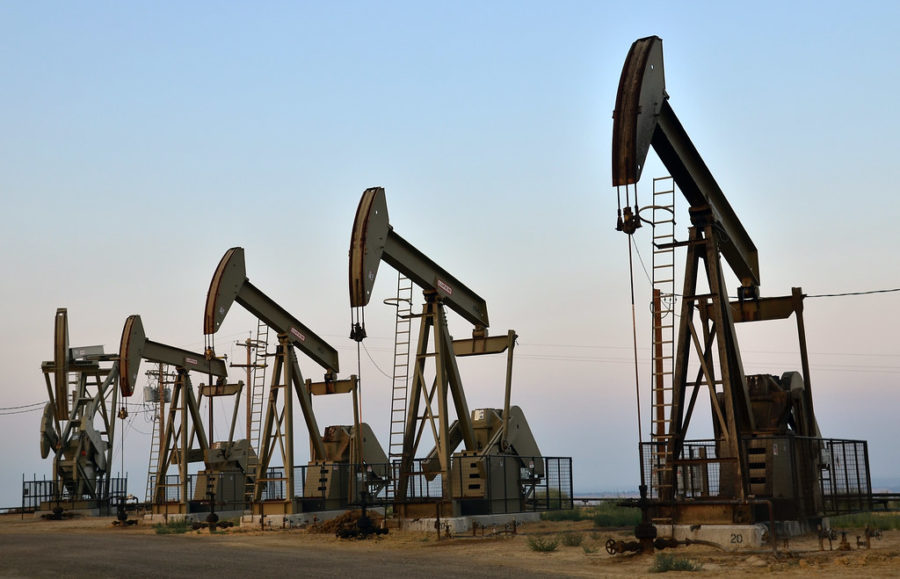
President Biden’s climate plans include a review of federal and state royalty rates paid by private companies for access to fossil fuel reserves underneath public lands.[i] On January 27, Biden issued Executive Order 14008, “Tackling the Climate Crisis at Home and Abroad,” urging aggressive domestic policy directives.[ii]
The Order directed the Secretary of the Interior to pause the issuance of new oil and gas leases for drilling rights on federal lands until the Secretary completes a “comprehensive review” of oil and gas permitting requirements.[iii] The Secretary subsequently issued Order No. 3395 (“the Order”), which directed the pause on approving new leases for fossil fuel extraction on federal lands and ordered the comprehensive review of federal royalty rates.[iv]
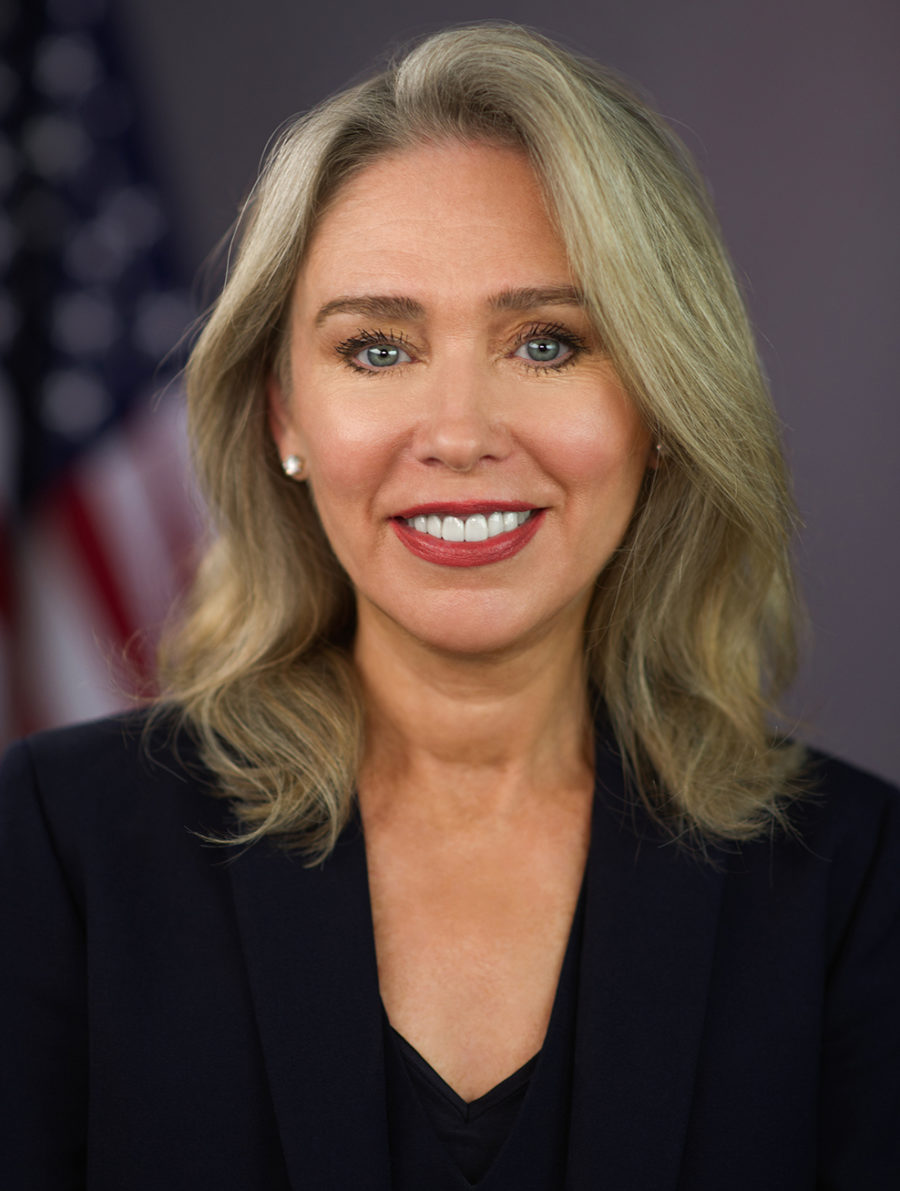
While the devastating effects of the global COVID-19 pandemic take center stage, another worldwide crisis “looms even larger than the pandemic and could have even more grave human and economic costs than those we have witnessed these last eight months.”[1]
Securities and Exchange Commission (SEC) Commissioner Allison Herren Lee addressed the threat of climate change on financial markets during her keynote remarks at the Practising Law Institute’s 52nd Annual Institute on Securities Regulation earlier this month.[2] Commissioner Lee—a Trump appointee—implored attendees to take climate change seriously, even while the crisis may appear to be an abstract threat to some.[3]
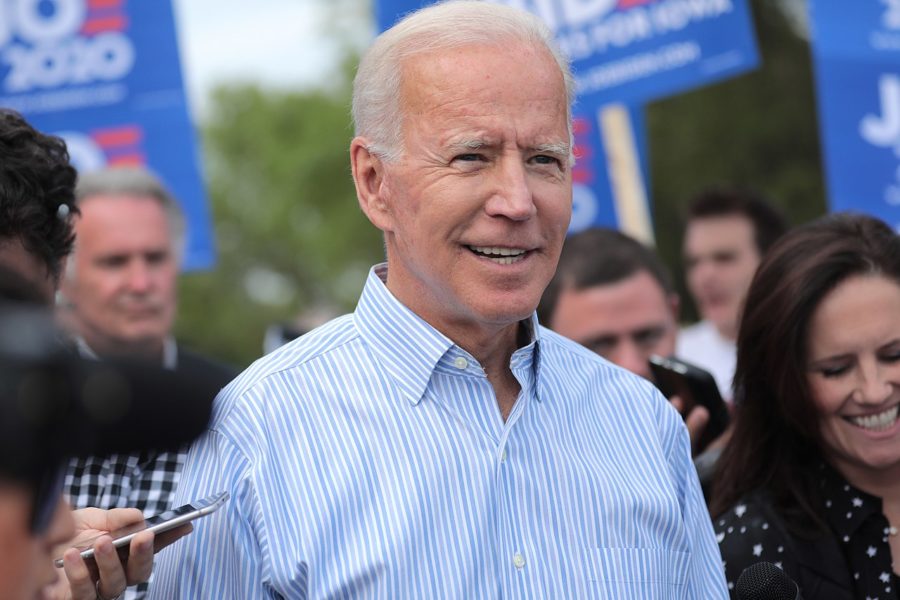
President-elect Joseph R. Biden faces a challenging road to inauguration day. But that road may be nothing compared to the to-do list waiting for him on January 21. The global pandemic and a struggling national economy are first-order priorities, but in addition to these emergent issues, energy and environmental policies were important topics for many voters during the election.[i]
Biden campaigned on a platform championing clean energy and environmental justice.[ii] Depending on the outcome of two senate runoff elections in Georgia, however, the president-elect may have to realize much of his administration’s climate and clean energy policies through executive action.[iii]

The state of Alaska’s 2018 request to exempt Tongass National Forest from environmental protections has cleared a major step in its evaluation process.[1] The U. S. Forest Service released a study indicating that loosening protections would not have significant impacts on Tongass, though environmental advocates are skeptical of its conclusions.[2] The Service’s Final Environmental Impact Statement considered several alternatives, but ultimately recommended a full exemption to the Roadless Rule for Tongass.[3]
Seeking Exemption to the Roadless Rule, a Clinton-Era Protection of National Forests
National Forest System lands are protected by the 2001 Roadless Rule, which “establishes prohibitions on road construction, road reconstruction, and timber harvesting on 58.5 million acres” of public land.[4] After weighing national policy concerns against giving discretion to local decisionmakers, the final rule was adopted in 2001 with the intention of providing lasting protection.[5] It concluded that local exemptions to nationwide protections could have significant negative impacts on lands subject to roadless protections.[6] The rule therefore opted for complete protection of 58.5 million acres of “roadless” areas, comprising just two percent of the United States’ continental landmass.[7] Successive Alaskan administrations, however, have pushed for Roadless Rule exemptions, and the current proposal would open 9 million of Tongass’ 16 million acres to commercial activity.[8]

Amid raging wildfires, heavy rains, and tornadoes— all of which have been linked to climate change—the United States is set to exit the Paris Agreement on November 4, one day after the presidential election.[1] President Trump, who has said that the global agreement to confront catastrophic climate change was a “total disaster” for the United States, formally issued the required one-year notice of withdrawal last November.[2] Former Vice President Joe Biden has stated that he would re-enter the U.S. into the Paris agreement if he wins the 2020 election.[3]
The 2015 Paris Agreement seeks to limit the “global temperature rise this century well below 2 degrees Celsius above pre-industrial levels,” and ideally less than 1.5 degrees Celsius.[4] Nations set their own goals for reducing greenhouse gas emissions through nationally determined contributions (NDCs).[5]
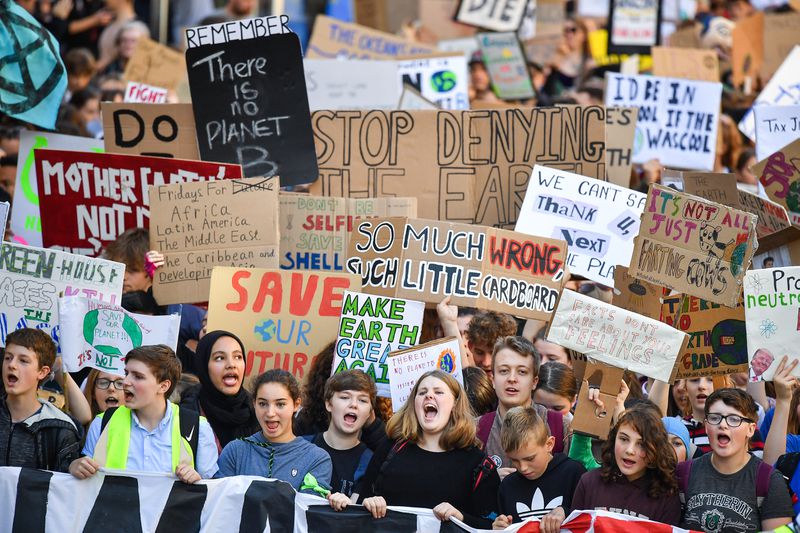
In Chicago, a group of local activists is joining the global FridaysForFuture movement by striking on Friday, November 29, 2019. The Deepstrike will take place at Daley Plaza, 50 W Washington St, Chicago, IL 60602. The Strike will last from 11:00am til 2:00pm. The organizers provided the following instructions:
- Wear black this #BlackFriday as we mourn the burning of the Amazon
- Bring old clothes for clothing swap
- Bring signs and posters if you have them
- Share pictures from the Strike
- Please tag #FridaysForFuture and #ClimateStrike on social media posts.
The official event page for the Strike can be found here.
According to #FRIDAYSForFUTURE’s website:
#FridaysForFuture is a movement that began in August 2018, after 15 years old Greta Thunberg sat in front of the Swedish parliament every school day for three weeks, to protest against the lack of action on the climate crisis. She posted what she was doing on Instagram and Twitter and it soon went viral.
On the 8th of September, Greta decided to continue striking every Friday until the Swedish policies provided a safe pathway well under 2-degree C, i.e. in line with the Paris agreement.
The hashtags #FridaysForFuture and #Climatestrike spread and many students and adults began to protest outside of their parliaments and local city halls all over the world. This has also inspired the Belgium Thursday school strikes.
The popularity of the youth driven movement has rapidly increased in the 14 months since Greta Thunberg first sat in front of parliament. To date, 60 thousand climate strike events, in 6.4 thousand cities across 222 countries, have attracted more than 11 million strikers.
*Featured Image: Chicago Tribune, Sep. 20, 2019, Getty Images
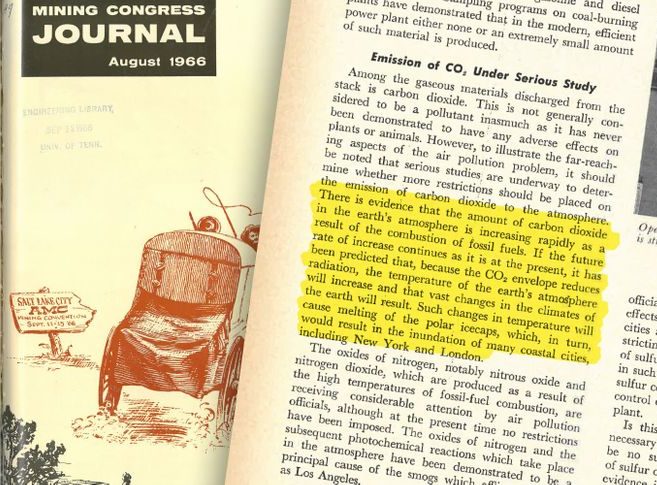
Evidence of what fossil fuel companies knew about the potentially negative impact of fossil fuel combustion on climate change is critical to the legal strategy of those seeking damages for carbon dioxide emissions. If the harmful effects of fossil fuel emissions were known to fossil fuel companies, they potentially could be held liable for damages.[1]
For decades coal companies have denied knowledge of the consequences, as well as the existence of climate change itself. The Huffington Post reported that although Peabody Energy,[2] the largest private-sector coal company in the world, acknowledges climate change on its website, “[i]t has been directly and indirectly involved in obfuscating climate science for decades. It funded dozens of trade, lobbying and front groups that peddled climate misinformation.”[3]
A recently discovered article, however, revealed that the coal industry has known of fossil fuel’s impact on climate change for decades.[4]
Chris Cherry, professor of civil engineering at the University of Tennessee, discovered an article published in the Mining Congress Journal in 1966, written by James R. Garvey, president of Coal Research Inc.[5] An article titled “ramifications of extractive technologies,”[6] revealed the coal industries foreknowledge. Garvey wrote:
There is evidence that the amount of carbon dioxide in the earth’s atmosphere is increasing rapidly as a result of the combustion of fossil fuels . . . [s]uch changes in temperature will cause melting of the polar icecaps, which, in turn, would result in the inundation of many coastal cities, including New York and London. [7]
Most modern knowledge of climate change is seen in the article including increase of average air temperature, melting of polar ice caps, and rising of sea levels.[8] Cherry’s discovery could potentially open the coal industry to similar litigation currently faced by the oil industry.[9]
The Huffington Post reached out to Peabody Energy for comment on the Article’s revelations. A Peabody spokesman stated:
Peabody recognizes that climate change is occurring and that human activity, including the use of fossil fuels, contributes to greenhouse gas emissions. We also recognize that coal is essential to affordable, reliable energy and will continue to play a significant role in the global energy mix for the foreseeable future. Peabody views technology as vital to advancing global climate change solutions, and the company supports advanced coal technologies to drive continuous improvement toward the ultimate goal of near-zero emissions from coal.[10]
*Featured Image: A 1966 issue of the Mining Congress Journal, Courtesy of Chris Cherry
[1] See Elan Young, Coal Knew, Too, Huffington Post (Nov. 22, 2019) https://www.huffpost.com/entry/coal-industry-climate-change_n_5dd6bbebe4b0e29d7280984f (last visited Nov. 22, 2019).
[2] https://www.peabodyenergy.com/.
[3] Élan Young, supra n.1; see Suzanne Goldenberg and Helena Bengtsson, Biggest US coal company funded dozens of groups questioning climate change, Guardian (June 13, 2016), https://www.theguardian.com/environment/2016/jun/13/peabody-energy-coal-mining-climate-change-denial-funding (last visited Nov. 22, 2019).
[4] Eoin Higgins, Coal Knew Too: Explosive Report Shows Industry Was Aware of Climate Threat as Far Back as 1966, Common Dreams (Nov. 22, 2019), https://www.commondreams.org/news/2019/11/22/coal-knew-too-explosive-report-shows-industry-was-aware-climate-threat-far-back-1966 (last visited Nov. 22, 2019).
[5] Id.
[6] Id.
[7] Élan Young, supra n.1
[8] Eoin Higgins, supra n.4.
[9] Id.
[10] Élan Young, supra n.1
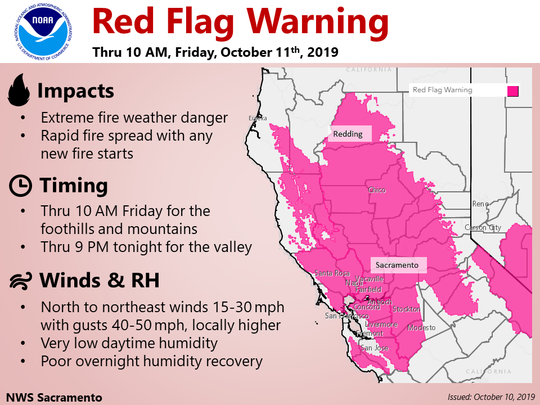
Threat of Wildfire Prompts California Utility Companies to Cut Power to Customers
On Wednesday, October 9, Pacific Gas & Electric Company (PG&E) began shutting off power to nearly 800,000 customers in northern California. PG&E stated that the outages were necessary to preempt the risk of wildfires brought on by severe weather conditions like high winds and hot, dry air throughout the company’s service area.[1] At the time PG&E initiated the outages, the company anticipated that some customers could be without power for days.[2]
Southern California Edison Company (SCE), the largest utility provider in south-central California, including Los Angeles County, announced on Thursday, October 10, that it would start cutting power to customers in light of the hazardous conditions caused by the Santa Ana winds.[3] The same day, wildfires broke out in SCE’s service area in Riverside County, east of Los Angeles.[4] SCE anticipates that over 200,00 customers may be affected by the power outages.[5]
These controlled blackouts, also known as “preemptive de-energizations,” are the foundation of PG&E and SCE’s Public Safety Power Shut-off programs (PSPS), which are part of a comprehensive effort to reduce the risk of electrical infrastructure sparking fires. This is accomplished by temporarily turning off power to specific areas.[6] Following the wildfires that devastated parts of California in 2017 and 2018, the California PUC ordered electric utility companies to submit Wildfire Mitigation Plans[7] and this past summer, California Governor Gavin Newsom signed a law that provides $21.5 billion in funding to help utilities pay for wildfire damage, and make upgrades to the electric infrastructure.[8] The California State Legislature, the California Public Utilities Commission (California PUC), and electric utility companies have, in turn, intensified their efforts to improve the safety of electric infrastructure as the threat of seasonal wildfires is exacerbated by changing climate. Dangerous weather conditions have started to subside, though line inspections may delay power returning to some PG&E customers for up to five days[9] and the fires in Riverside County continue to burn.[10]
Featured Image: National Weather Service Sacramento
[1] See Press Release, PG&E Begins to Proactively Turn Off Power for Safety to Nearly 800,000 Customers Across Northern and Central California, Pacific Gas & Electric Company (Oct. 9, 2019), https://www.pge.com/en/about/newsroom/newsdetails/index.page?title=20191009_pge_begins_to_proactively_turn_off_power_for_safety_to_nearly_800000_customers_across_northern_and_central_california (last visited Oct. 9, 2019).
[2] Id.
[3] See Press Release, , Santa Ana Winds Prompt SCE Public Safety Power Shutoffs in Some Southland Areas, Southern California Edison Company (Oct. 10, 2019), https://energized.edison.com/stories/santa-ana-winds-prompt-sce-public-safety-power-shutoffs-in-some-southland-areas.
[4] See Joseph Serna, Hannah Fry, & Alejandra Reyes-Velarde, Numerous Riverside County homes destroyed by fire; SoCal Edison cuts power to thousands, The Los Angeles Times (Oct. 10, 2019), https://www.latimes.com/california/story/2019-10-10/l-a-faces-critical-fire-danger-possible-power-outages-as-santa-ana-winds-buffet-southern-california (last visited Oct. 10, 2019).
[5] See Public Safety Power Shutoffs, Current Status, Southern California Edison Co (effective Oct. 11, 2019), https://www.scemaintenance.com/content/sce-maintenance/en/psps.html (last visited Oct. 11, 2019).
[6] See Rulemaking 18-12-005, Decision Adopting De-Energization (Public Safety Power Shutoff) Guidelines (Phase I Guidelines), California PUC, p. 3 (issued May 30, 2019).
[7] See Rulemaking 18-10-007, Order Instituting Rulemaking to Implement Electric Utility Wildfire Mitigation Plans Pursuant to Senate Bill 901 (2018), California PUC (issued Oct. 25, 2018).
[8] See Alejandro Lazo & Katherine Blunt, California Legislature Approves Multibillion-Dollar Wildfire Fund, The Wall Street Journal (July 11, 2019), https://www.wsj.com/articles/california-legislature-approves-multibillion-dollar-wildfire-fund-11562870591 (last visited Oct. 11, 2019).
[9] See Thomas Fuller, Californians Confront a Blackout Induced to Prevent Blazes, The New York Times (Oct. 10, 2019), https://www.nytimes.com/2019/10/10/us/pge-outage.html (last visited Oct. 11, 2019).
[10] Incident Overview, California Department of Fire & Forestry Protection, https://www.fire.ca.gov/incidents/ (last visited Oct. 11, 2019).

Iceberg More Than Twice the Size of Chicago Breaks Off Antarctica
On September 26, 2019, an iceberg measuring 632 square miles, weighing 315 billion tons, calved from an ice shelf in east Antarctica.[1] Calving is the sudden release of ice from the edge of a glacier, iceberg, or ice shelf. This event is the first major calving on the Amery ice shelf in over 50 years.[2]
Scientists do not attribute this large break of ice to climate change—despite it being the largest event in decades. Helen Amanda Fricker, a professor at the Scripps Institution of Oceanography, states, “It’s part of the ice shelf’s normal cycle, where we see major calving events every 60-70 years.”[3]
While this event is not believed to be a direct result of climate change, calving in other areas is beginning to increase in depth and speed. Sue Cook from the Institute of Marine and Antarctic Studies expects iceberg calving incidents to increase in coming years due to climate change.[4] Cook explains, “There are a number of different processes that’ll happen . . . [a]s waters around Antarctica warm up, they’ll start thinning the ice shelves and making them more vulnerable to breaking up.”[5]
Featured Image: COPERNICUS DATA/SENTINEL-1/@STEFLHERMITTE, https://www.bbc.com/news/science-environment-49885450.
[1] See Lisa Cox, Giant iceberg breaks off east Antarctica, The Guardian (Sept. 30, 2019), https://www.theguardian.com/world/2019/oct/01/giant-iceberg-breaks-off-east-antarctica (last visited Oct. 10, 2019); Jonathan Amos, 315 billion-tonne iceberg breaks off Antarctica, BBC News (Sept. 30, 2019), https://www.bbc.com/news/science-environment-49885450 (last visited Oct. 11, 2019).
[2] Id.
[3] Id.
[4] See Carly Cassella, A Giant Iceberg Just Broke Off Antarctica in an Unexpected Location, Science Alert (Oct, 2, 2019), https://www.sciencealert.com/a-giant-iceberg-has-just-broken-off-antarctica-and-it-s-bigger-than-expected (last visited Oct. 10, 2019).
[5] Id.

